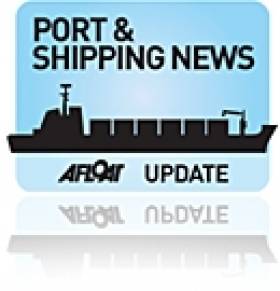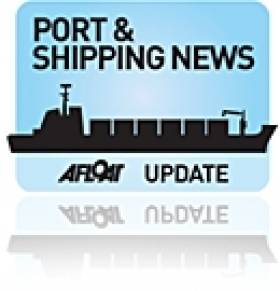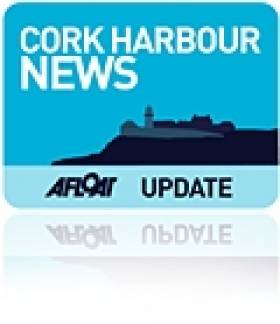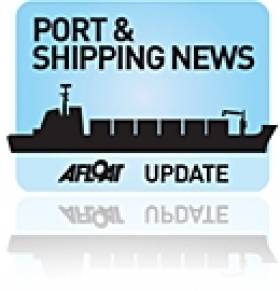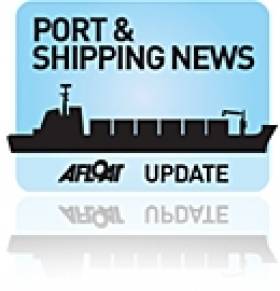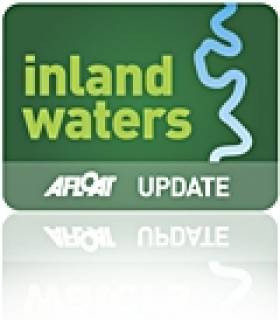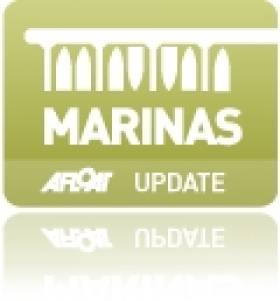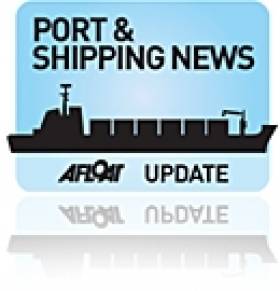Displaying items by tag: Port
Ship Owner Fined for Overloading
#SHIPPING – At a hearing yesterday at Southampton Magistrates Court the German owners of the Antigua and Barbuda registered cargo vessel 'Katja' pleaded guilty to the overloading of their vessel which had arrived in Liverpool laden with rock salt from the St. Lawrence Seaway, Canada in November 2010.
The vessel was loaded to its marks with rock salt and sailed from Goderich to arrive at the Manchester Ship Canal on the 23rd November 2010. Rock salt was in high demand to treat UK highways at this time.

The 'Katja' - Photo: courtesy of Maritime and Coastguard Agency
As the vessel entered the River Mersey, the pilot on another passing vessel noticed that the Plimsoll Line and load lines were not visible and the vessel appeared very low in the water. When the vessel arrived in the Queen Elizabeth II Dock it was inspected by MCA Port State Control Officers who found that the load line that marks the safety limit of the vessel was submerged by 39.5 cm.
Katja Schiffahrtsges Gmbh of Haren, Ems, Germany, owner of the ship Katja, was fined £28015 plus costs of £5000 awarded to the MCA.
In summing up the Magistrates stated "We share the Maritime and Coastguard Agency's view of the seriousness of the case, however accept that the overloading was not for gain. We have also considered the early plea of guilty and have reduced the fine of £42000 accordingly.
Simon Milne, from the Maritime and Coastguard Agency said:
"Since the good work of Samuel Plimsoll, the application and enforcement of load line marks have prevented the loss of many vessels and have saved the lives of many seafarers.
Imminent Transfer of Genmar Oil Cargo
#GENMAR – After delays due to bad weather, the operation to remove 54,304 tonnes of Vacuum Gas Oil from the merchant vessel Genmar Companion is expected commence imminently (6th January).
Both ships are currently being manoeuvred together by tugs and are being held side- by-side 1.5miles out in Belfast Lough. The cargo is transferred from one to the other using specialist equipment.
The operation to berth, make lines secure and conduct final checks will take several hours before the actual transfer of the oil begins.
The operation to offload the cargo to the tanker BW Seine is expected to take between 24 and 36 hours. For the duration of the operation there will be a one- mile exclusion zone around the Genmar Companion and BW Seine to give the tugs a safe working area.
#CORKHARBOUR – Calling all 5th Class Teachers! Win a Free Boat Trip around Cork Harbour for your class. The Port of Cork has launched their Schools Initiative for 2012 and is calling on all 5th class primary school teachers to get their class involved. This year's initiative is based on the theme 'Ships, Steam Trains and Seaplanes – the Cork Harbour Connection' and encourages school children to research Cork harbour and these methods of transports used in the past and today.
The Port of Cork Schools Initiative aims to teach 5th class primary school children about the rich history of Cork Harbour and its uses today as a natural harbour, commercial port and excellent leisure amenity. All participating 5th classes who take part in the Port of Cork Schools Initiative will be treated to a boat trip around Cork harbour, compliments of the Port of Cork and each class will also receive a certificate of participation. Awards will be given for the best artwork piece and best photograph. The overall best project will receive a tour on board one of the many large cruise liners visiting Cork during the summer of 2012.
Speaking about the 2012 theme, Captain Pat Murphy said: "This year's theme encourages classes to research the history of ships, steam trains and seaplanes within Cork Harbour over past generations and perhaps compare these modes of transport to those used today. Cork Harbour has a rich history of different transport modes and many people may not know that Aghada on the East side of the harbour was a base for American Seaplanes during the early 1900's. Though dramatically changed, ships, trains and seaplanes are still used in Cork Harbour today."
He added: "2012 will also see the centenary of RMS Titanic commemorated in Cobh, highlighting Cork's rich history with large Trans-Atlantic liners calling to the port. The 150th anniversary of the first train service on the Cork – Cobh line also takes place this year."
Projects are to be presented in artwork format using paintings, models or photographs. Submitted projects will go on public display in Customs House before the winner is announced in April 2012. Closing date for entries is 30th March 2012.
For more information on this year's schools project and how to get involved, please contact Captain Pat Murphy Tel: 021 4625312
Trade Freight Volumes Through Seaports Still Down 9% on 2007
#SHIPPING – The Irish Exporters Association launched its Trade and Transport Analysis 2011 today (13th Dec) in Cork and its findings confirmed that 2010 was a story of recovery after two straight years of decline in 2008 and 2009. Importantly, the recovery trend has not continued into 2011, and exporters fear that shipping lines may not be able to continue the service levels they need to meet new market requirements.
Speaking at the launch of the Trade and Transport Analysis 2011 at the Port of Cork, Mr John Whelan, Chief Executive at the Irish Exporters Association, said that the analysis shows;
• export volumes have now returned to the pre –recession levels
• but import volumes are still 12.9% below 2007 levels. The analysis further shows that airfreight imports are down by 36% indicating a dramatic loss in high value luxury imports, whereas sea-freight imports are down by over 9%, reflecting the depressed domestic economy.
Mr Brendan Keating, Chief Executive Officer at the Port of Cork, welcoming exporters to the launch event stated; ''A 9% increase in exports are expected through the Port of Cork during 2011, which is very positive for the region.''
He went on to say the Port of Cork is committed to supporting the growth of international trade and meeting the needs of exporters and importers of goods , particularly from the distant but rapidly growing Asian and South American markets . He also pointed to the Ports commitment by sponsoring the Deep Sea Shipping Award with the Irish Exporters Association. He concluded by saying; "The Port of Cork is happy to be associated with the Irish Exporters Association in producing the Trade and Transport Analysis 2011."
"The growth in exports volumes to pre –recession levels reflects the rapid' V ' shaped bounce back by the export sector which was achieved despite the depressed international economic environment," said Mr Whelan. However, he went on to say, the continued low volume of imports is inevitably putting huge strain on the shipping lines and airfreight lines servicing the country. "Exporters are concerned that the continued loss of volumes will lead to a deterioration of competitive services from shipping lines and haulage contractors, less revenue for ports and ultimately higher transport costs for our manufacturing export sector."
He further stated; "Major job losses in manufacturing industry will accelerate unless a new integrated transport strategy is put in place to enable Irish exporters to effectively transport key imports from the major Asian supply industries into Ireland and manufacture and distribute exports into Europe and America as well as back to Asia."
John Whelan then said; "In this context exporters find it befalling that in the recent Budget that added costs were put onto the transport sector without making allowances for the export sector . Once again we are asking the Minister for Transport Leo Varadkar T.D. to introduce a Special Diesel User Rebate to support transport and export industry to ensure we have a level playing field in Europe with competitors from other EU member states who enjoy this kind of support from their governments."
The publication launched today, sponsored by the Port of Cork, looks in detail at all of the various modes of transport that are currently used to export and to import. The publication also looks at the risk factors to Irish trade which need to be addressed as a matter of urgency. High up on that list is the lack of regular air freight routes into and out of Ireland which accounts for 37% by value of all exports or almost €33 billion were carried by air in 2010. However, this may not be the full picture because the CSO figures only indicate the mode of transport used to move the goods across the border of the Irish state and does not take into account which mode of transport is used after that point. It therefore seems likely that the figures for air freight quoted above may in fact not reflect the total potential airfreight value as it is likely that a proportion of air freight is leaving Ireland by other modes in order to be air freighted from hubs in the UK or continental Europe to their final destination.
Mr Whelan concluded by saying that Ireland must continue to reinforce its existing strengths as one of the most open and globalized economies in the world (currently ranked Number Two on the Ernst & Young Globalization Index). "We must build on our progress so far by effectively resolving our transport challenges in an imaginative way and with a strong sense of urgency and determination."
Shannon Estuary's Deep Waters Hold Key to Trans Shipment Potential
The potential for developing a 'transhipment port' on the Shannon Estuary topped the agenda of meetings held by Sean Kelly MEP and leading US politicians and business people at Jacksonville, USA - home to one of the largest commercial cargo ports on the Atlantic Coast.
International maritime consultant, John Martin, recently identified the Shannon Estuary as having potential for a bulk transshipment centre due to its 16 meter depth waters. Most UK and European ports have channel depth of just 10 meters, limiting the size of vessels that can be accommodated. This is a gap in the cargo market that Shannon can fill according to Mr Kelly.
"The study by Mr Martin indicated feasibility for the establishment of a port at Shannon to receive cargo vessels drawing in excess of 15 meters and particularly dry bulk goods. The cargo could be broken down in Shannon (Ships of 15+ metres draft) and shipped in smaller tonnage vessels (ships of 6.4 to 12.5 metres draft) to Nordic countries and European smaller ports. Mr Martin also pointed out that there could be significant savings for shipping companies using this method when transporting dry bulk goods when compared to using ports with limited water depth.
"The development itself would represent a multi-million boost for the region, creating employment both directly and indirectly through spin-off industries. It is an idea I would like to see fully investigated and that is why I raised the issue with US politicians on my visit to Jacksonville in the last few days, as part of my work as a member of the EU-US Parliamentary Relations Committee.
"Ireland and the US enjoy a proud tradition as trading partners and location-wise, a port facilitating North American shipping companies is very logical. US Senators, Congressmen and business leaders reacted positively to the idea and it is something I will pursue further as an MEP for Ireland South," Mr Kelly concluded.
Amongst those present at the talks was a US citizen with Kerry ancestry - Mike Breen the Senior Director International Department at Jacksonville Regional Chamber of Commerce, and Jerry Mallot - President at Cornerstone Regional Development Partnership.
900 Brazilian Delegates Come to Cork
Cork Convention Bureau (CCB) has been working with Kuoni on an impressive itinerary for next year. A group of 12 visited Cork on September 17th and 18th last on a fact finding mission. CCB ensured they experienced the best of the region including a visit to the coastal town of Kinsale, the Queenstown Heritage Centre in Cobh, Fota House and even a night at the dog races! As a result of this site inspection a programme has been devised. A gala dinner in the grounds of Castlemartyr Resort Hotel with the backdrop of the castle ruins has been proposed followed by a day of excursions including the Jameson Distillery in the town of Midleton and the obligatory kissing of the Blarney Stone. Two hours of free time in Cork's city centre will allow the group to browse the chic boutiques and have lunch at many of Cork's great restaurants tasting local artisan produce.
'This business will be worth an estimated €500,000 to the Cork region. Since its inception in 2007, CCB has been responsible for more than €20 million worth of conference, meeting and incentive business in Cork. Cork is at its peak right now and international event organisers looking for new destinations are very impressed with the product offering.' Evelyn O'Sullivan, Business Tourism Manager CCB. (Cork Convention Bureau is an initiative of Cork City and County Councils, Failte Ireland and is also supported by the regions hotels.)
Commenting on the delegate visit to Cork, Captain Michael McCarthy Port of Cork said: "This is a fantastic opportunity for Cork to leave a very positive welcoming experience for the 900 visitors. It is very encouraging to see commercial companies using the cruise liner business as a method of visiting the region. Statistics available from the cruise lines indicate that 30% of cruise passengers make a return visit to a region they visited on their cruise itinerary. This would be excellent for Cork if some or all of these delegates return in the future with their family or friends or indeed looked at future business opportunities." In order to ensure that their visit is memorable, the Port of Cork will coordinate a special welcome with the Tour Operator, Cobh Tourism, Town Council and Chamber, Irish Rail and Cork City TEAM.
He continued: "The Port of Cork has been involved for the last 3 years with Spanish, French and Portuguese Ports in developing the European Atlantic Area as a premier cruise destination. This work under an EU Initiative "Cruise Atlantic Europe" is aimed at developing the historic links between these countries and the Latin nations in South America, particularly Brazil to encourage them to visit this region. The Independence of the Seas is due to berth in the Port of Cork between the 6th-7th May 2012 with over 5,000 passengers and crew.
Port of Cork Announce Agri-food Sector Investment
Arkady Feed Ltd is a leading player in the importation and trading of feedstuffs for the animal feed sector in Ireland. The animal feed sector is a vital link in Ireland's €8bn agri-food sector. The construction of this new store by Arkady Feed Ltd is a vote of confidence in the animal feed and agri-food sectors by the company. BAM contractors have been awarded the contract to build the facility on behalf of Arkady Feed Ltd.
Minister Simon Coveney today said: "I wish Arkady Feed Ltd every success for their new bulk feed store here in Ringaskiddy, Co. Cork. The dry bulks sector is up 9% for the first 9 months of 2011, according to figures recently published by the IMDO, which shows that this sector is likely to see further growth in the future."
Gary McGuigan, a Director of Arkady Feed Ltd said: "This very important strategic investment in our own storage facility in the Port of Cork, will allow us to grow our business here in Ireland and be a stronger partner with our customers as they too grow over the coming years. While our industry is facing a number of serious issues that will hamper growth in the short term we feel very strongly that our industry is well placed for growth in the medium to long term."
Brendan Keating, CEO of Port of Cork Company said: "The Port of Cork Company is delighted that Arkady Feed Ltd has chosen Ringaskiddy as the location for this significant investment. We are confident that with our unique deep-water port facilities in Ringaskiddy we can help and support Arkady as they expand their business. In offering our full support we commit to working with Arkady Feed Ltd in the achievement of growth."
Shillington's Quay in Portadown Set for Revamp
Shillington's Quay in Portadown is set for redevelopment thanks to a significant grant from the European Union.
The Portadown Times reports that half of the borough's £200,000 (€230,000) funding will be used for a new floating jetty and environmental improvements for the Newry Canal quay area, which was last used as a working port in the 1930s.
A total of £2.5 million (€2.9 million) has been earmarked by the EU for promoting tourism in the cross-border East Border Region, which aside from six Northern Ireland council areas also includes the Irish counties of Louth, Meath and Monaghan.
Other improvements to marine and waterway facilities include a £125,000 (€145,000) investment for the Eisenhower Pier in Bangor, on the southern side of Belfast Lough.
The Portadown Times has more on the story HERE.
New Mooring Facilities on River Foyle
Port Harbour master, Bill McCann says this is "positive step forward towards harnessing the potential of the River Foyle for tourism and commerce. The new cruise ship quay at Meadowbank, together with the new pontoon, add significantly to the marine facilities that we offer on the Foyle, which is particularly important with the Clipper Round the World Yacht Race calling at Derry in 2012."

Londonderry Port and Harbour Commissioners sign contract for development of Foyle cruise ship quay and pontoon
Chief executive of the Loughs Agency, Derick Anderson has expressed his enthusiasm for a project "that promises to aid the development of tourism along the Foyle and in the north-west generally, including Inishowen. The new water front infrastructure may reveal fresh opportunities for those planning events in the region, for instance, City of Culture in 2013. The Loughs Agency is optimistic that the project will optimise potential for water based events and activity and help bring the river to life in Londonderry's city centre."
Shaun Henry from the Special EU Programmes Body highlighted the strategic importance of this initiative for the region saying: "This project will allow the local tourism sector to draw on the natural environment of the region and its natural tourism resources. This is likely to attract a higher number of domestic and overseas visitors, contributing to improving the performance of the overall tourism industry, one of the key priorities of the INTERREG IVA Programme. By increasing the offer for high quality marine facilities in the area, it also builds on the strong cultural and economic linkages that exist between western Scotland, Northern Ireland and the west coast of Ireland, where marine tourism is a sector in expansion."
The project is supported by funds from the European Regional Development Fund. The Loughs Agency is lead partner in an Interreg IV programme that secured this funding for some much needed infrastructure. Details about marine leisure on the Foyle on www.loughs-agency.org or www.londonderryport.com
O'Hanlon Firm Wins Tender to Operate Dundalk Port
At the time of the Minister's announcement in May, Mr. Varadkar indicated his hope that port activities would continue at Dundalk following the transfer and of a possibility that the port could return to local control, in co-operation with private sector operators. Today's announcement means that the under the terms of the agreement O'Hanlon & Sons Contractors Ltd., a local company, will be responsible for all commercial and operational matters in Dundalk Port.
Commenting on the announcement, Mr. Eamonn O'Reilly, Chief Executive, Dublin Port Company said: "I am delighted today to be able to confirm that we have entered into an agreement with O'Hanlon & Sons Contractors Ltd. to operate the Dundalk Port. This is a unique development in the Irish port sector but I believe that if Dundalk is to have a future it is best to have local private sector interests empowered to carve out a future for themselves, for the port and for everybody who depends on the port."




























